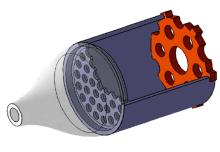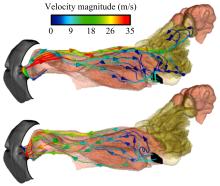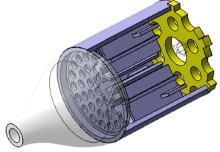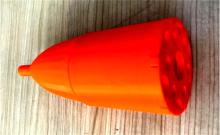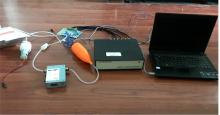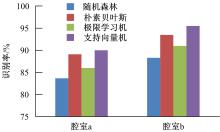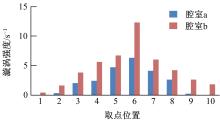Journal of Jilin University(Engineering and Technology Edition) ›› 2020, Vol. 50 ›› Issue (1): 382-388.doi: 10.13229/j.cnki.jdxbgxb20181069
Oil and gas detection method and experimental new technology based on bionic nasal chamber optimization
Xiao-hui WENG1,2,3( ),You-hong SUN4,Shu-jun ZHANG1,2,5,Jun XIE1,2,Zhi-yong CHANG1,2,4(
),You-hong SUN4,Shu-jun ZHANG1,2,5,Jun XIE1,2,Zhi-yong CHANG1,2,4( )
)
- 1. Key Laboratory of Bionic Engineering, Ministry of Education, Jilin University, Changchun 130022, China
2. College of Biological and Agricultural Engineering, Jilin University, Changchun 130022, China
3. College of Mechanical and Aerospace Engineering, Jilin University, Changchun 130022, China
4. National?Local Joint Engineering Laboratory of In?situ Conversion, Drilling and Exploitation Technology for Oil Shale, Jilin University, Changchun 130021, China
5. School of Computing and Technology, University of Gloucestershire, The Park, Cheltenham GL50 2RH, UK
CLC Number:
- TH763
| 1 | 李樟云 . 随钻气体分离先导技术研究[D]. 厦门: 厦门大学化学化工学院, 2011. |
| Li Zhang-yun . Study on pilot technology of gas separation while drilling[D]. Xiamen: College of Chemistry and Chemical Engineering,Xiamen University, 2011. | |
| 2 | Sun Xi-yang , Liu Lin-feng , Wang Zhan . An optimized multi-classifiers ensemble learning for identification of ginsengs based on electronic nose[J]. Sensors and Actuators A: Physical, 2017, 266: 135-144. |
| 3 | 张哲 . 仿生电子鼻传感器阵列设计及其在牛肉品质检验中的应用[D]. 长春: 吉林大学生物与农业工程学院, 2008. |
| Zhang Zhe . Designs of sensor matrixes for biomimetic electronic nose and their application in detection of beef quality[D]. Changchun: College of Biological and Agricultural Engineering,Jilin University, 2008. | |
| 4 | 常志勇, 陈东辉, 佟月英, 等 . 基于人体嗅觉特征的猪肉新鲜度仿生电子鼻检测技术[J]. 吉林大学学报:工学版, 2012, 42(增刊1): 131-134. |
| Chang Zhi-yong , Chen Dong-hui , Tong yue-ying , et al . Human olfactory feature based bionic electronic nose technology for pork freshness detection[J]. Journal of Jilin University(Engineering and Technology Edition), 2012, 42(Sup.1): 131-134. | |
| 5 | Zhou H , Luo D , Gholam H H , et al . Identification of Chinese herbal medicines with electronic nose technology: applications and challenges[J]. Sensors, 2017, 17(5):No.1073. |
| 6 | Li Shang-zhen , Zeng Su-ling , Wu Yan , et al . Cultivar differentiation of Citri Reticulatae Pericarpium by a combination of hierarchical three-step filtering metabolomics analysis, DNA barcoding and electronic nose[J]. Analytica Chimica Acta, 2019, 1056: 62-69. |
| 7 | Sun H , Tian F , Liang Z , et al . Sensor array optimization of electronic nose for detection of bacteria in wound infection[J]. IEEE Transactions on Industrial Electronics, 2017, 64(9): 7350-7358. |
| 8 | Domenico Cipriano , Laura Capelli . Evolution of electronic noses from research objects to engineered environmental odour monitoring systems: a review of standardization approaches[J]. Biosensors, 2019, 92(2): No.75. |
| 9 | Zarra T , Cimatoribus C , Naddeo V , et al . Environmental odour monitoring by electronic nose[J]. Global Nest Journal, 2019, 20(3): 664-668. |
| 10 | Yang H , Nguyen Q T , Ping Z , et al . Desorption and pervaporation properties of zeolite-filied poly(dimethylsiloxane) membranes[J]. Material Research Innovations, 2001, 5(2): 101-106. |
| 11 | Wen J , Inthavong K , Tu J , et al . Numerical simulations for detailed airflow dynamics in a human nasal chamber[J]. Respiratory Physiology & Neurobiology, 2008, 161(2): 125-135. |
| 12 | Falcitelli M , Benassi A , Francesco F D , et al . Fluid dynamic simulation of a measurement chamber for electronic noses[J]. Sensors and Actuators B: Chemical, 2002, 85(1/2): 166-174. |
| 13 | Waldrop L D , Hann M , Henry A K , et al . Ontogenetic changes in the olfactory antennules of the shore crab, Hemigrapsus Oregonensis, maintain sniffing function during growth[J]. Journal of the Royal Society Interface, 2015, 102 (12):1-19. |
| 14 | Che H F K , Taylor J E , Covington J A , et al . An electronic nose employing dual-channel odour separation columns with large chemosensor arrays for advanced odour discrimination[J]. Sensors and Actuators B: Chemical, 2009, 141(1): 134-140. |
| 15 | Giacomo Viccione , Daniele Spiniello , Tiziano Zarra , et al . Fluid dynamic simulation of odour measurement chamber[J]. Chemical Engineering Transactions, 2014, 40: 109-114. |
| 16 | 魏荣兴 . 影响犬嗅觉能力的相关因素[J]. 黑龙江畜牧兽医, 2016(16): 189-190. |
| Wei Rong-xing . Related factors affecting dogs'olfactory ability[J]. Heilongjiang Animal Science and Veterinary Medicine, 2016(16): 189-190. | |
| 17 | Craven Brent A , Paterson Eric G , Settles Gary S . The fluid dynamics of canine olfaction: unique nasal airflow patterns as an explanation of macrosmia[J]. Journal of the Royal Society Interface, 2009, 47(7): 933-943. |
| 18 | Craven Brent A , Paterson Eric G , Settles Gary S . Development and verification of a high-fidelity computational fluid dynamics model of canine nasal airflow[J]. Journal of Biomechanical Engineering, 2009, 131(9): 091002. |
| 19 | Zhao K , Dalton P , Yang G C , et al . Numerical modeling of turbulent and laminar airow and odorant transport during snifng in the human and rat nose[J]. Chemical Senses, 2006, 31(2): 107-118. |
| 20 | Francesco F D , Falcitelli M , Marano L , et al . A radially symmetric measurement chamber for electronic noses[J]. Sensors and Actuators B: Chemical, 2005, 105(2): 295-303. |
| [1] | Bin-bin YU,Liang HU,Ling CHI. Digital signature scheme against internal and external attack for wireless sensor networks [J]. Journal of Jilin University(Engineering and Technology Edition), 2019, 49(5): 1676-1681. |
| [2] | Guang YAN,Jian-zhong LU,Kai-yu ZHANG,Fan-yong MENG,Lian-qing ZHU. Temperature decoupling large range fiber Bragg grating strain sensor [J]. Journal of Jilin University(Engineering and Technology Edition), 2019, 49(5): 1682-1688. |
| [3] | Peng-yu WANG,Shi-jie ZHAO,Tian-fei MA,Xiao-yong XIONG,Xin CHENG. Vehicle multi-sensor target tracking and fusion algorithm based on joint probabilistic data association [J]. Journal of Jilin University(Engineering and Technology Edition), 2019, 49(5): 1420-1427. |
| [4] | Shun YANG,Yuan⁃de JIANG,Jian WU,Hai⁃zhen LIU. Autonomous driving policy learning based on deep reinforcement learning and multi⁃type sensor data [J]. Journal of Jilin University(Engineering and Technology Edition), 2019, 49(4): 1026-1033. |
| [5] | Kai XU,Zhi⁃gang CHEN,Jing⁃hua ZHAO,Lu DAI,Feng LI. Layout design method of star sensor based on particle swarm optimization algorithm [J]. Journal of Jilin University(Engineering and Technology Edition), 2019, 49(3): 972-978. |
| [6] | DING Ning, CHANG Yu-chun, ZHAO Jian-bo, WANG Chao, YANG Xiao-tian. High-speed CMOS image sensor data acquisition system based on USB 3.0 [J]. 吉林大学学报(工学版), 2018, 48(4): 1298-1304. |
| [7] | DONG Ying, CUI Meng-yao, WU Hao, WANG Yu-hou. Clustering wireless rechargeable sensor networks charging schedule based on energy prediction [J]. 吉林大学学报(工学版), 2018, 48(4): 1265-1273. |
| [8] | LIU Kun, LIU Yong, YAN Jian-chao, JI Shuo, SUN Zhen-yuan, XU Hong-wei. Dynamic analysis of sit-to-stand human motion based on in vitro-sensor detection [J]. 吉林大学学报(工学版), 2018, 48(4): 1140-1146. |
| [9] | CHEN Ming, CHEN Jie, XIAO Jing-bo. Design of pipeline analog digital converter used for CMOS image sensors [J]. 吉林大学学报(工学版), 2018, 48(3): 968-976. |
| [10] | LIU Zhou-zhou, PENG Han. Topology control algorithm based on node reliability in WSN [J]. 吉林大学学报(工学版), 2018, 48(2): 571-577. |
| [11] | QIAN Zhi-hui, ZHOU Liang, REN Lei, REN Lu-quan. Completely passive walking machine with bionic subtalar joint and matatarsal phalangeal joint [J]. 吉林大学学报(工学版), 2018, 48(1): 205-211. |
| [12] | TANG Kun, SHI Rong-hua. Detection of wireless sensor network failure area based on butterfly effect signal [J]. 吉林大学学报(工学版), 2017, 47(6): 1939-1948. |
| [13] | CHEN Dong-hui, LIU Wei, LYU Jian-hua, CHANG Zhi-yong, WU Ting, MU Hai-feng. Bionic design of corn stubble collector based on surface structure of Patinopecten yessoensis [J]. 吉林大学学报(工学版), 2017, 47(4): 1185-1193. |
| [14] | WANG Yong, SUN Dong-ye, QI Zheng-gang. Aging simulation method for EFI engine oxygen sensor based on first order inertial filter algorithm [J]. 吉林大学学报(工学版), 2017, 47(4): 1040-1047. |
| [15] | YU Bin-bin, WU Xin-yu, CHU Jian-feng, HU Liang. Signature protocol for wireless sensor network based on group key agreement [J]. 吉林大学学报(工学版), 2017, 47(3): 924-929. |
|
||
